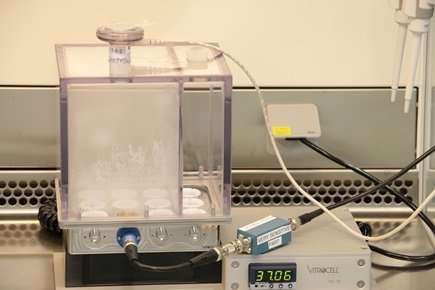Three-dimensional cell cultures "inhale" particles
The research team headed by Peter Wick, Tina Brki and Jing Wang from Empa and Barbara Rothen-Rutishauser and Barbara Drasler from AMI recently published their first results in the journal Carbon. Thanks to the 3-D lung model, the researchers have succeeded in simulating the actual conditions at the blood-air barrier and the impact of graphene on the lung tissue as realistically as possible – without any tests on animals or humans. It is a cell model representing the lung alveoli. Conventional in vitro tests work with cell cultures from just one cell type – the newly established lung model, on the other hand, bears three different cell types, which simulate the conditions inside the lung, namely alveolar epithelial cells and two kinds of immune cells – macrophages and dendritic cells.
 The lung model at Adolphe Merkle Institute (AMI) in Fribourg. Credit: AMI
The lung model at Adolphe Merkle Institute (AMI) in Fribourg. Credit: AMI Another factor that has virtually been ignored in in vitro tests thus far is the contact with airborne graphene particles. Usually, cells are cultivated in a nutrient solution in a petri dish and exposed to materials, such as graphene, in this form. In reality, however, i.e. at the lung barrier, it is an entirely different story. "The human organism typically comes into contact with graphene particles via respiration," explains Tina Brki from Empa's Particles-Biology Interactions lab.
In other words, the particles are inhaled and touch the lung tissue directly. The new lung model is designed in such a way that the cells sit on a porous filter membrane at the air-liquid interface and the researchers spray graphene particles on the lung cells with the aid of a nebulizer in order to simulate the process in the body as closely as possible. The three-dimensional cell culture thus effectively "breathes in" graphene dust.
No acute damage discovered
These tests with the 3-D lung model have now yielded the first results. The researchers were able to prove that no acute damage is caused to the lung if lung epithelial cells come into contact with graphene oxide (GO) or graphene nanoplatelets (GNP). This includes responses such as sudden cell death, oxidative stress or inflammation.